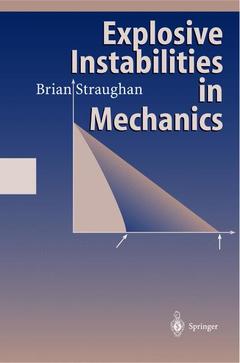Explosive Instabilities in Mechanics, Softcover reprint of the original 1st ed. 1998
Langue : Français
Auteur : Straughan Brian

The subject of blow-up in a finite time, or at least very rapid growth, of a solution to a partial differential equation has been an area of intense re search activity in mathematics. Some ofthe early techniques and results were discussed in the monograph by Payne (1975) and in my earlier monograph, Straughan (1982). Relatively recent accounts of blow-up work in partial dif ferential equations may be found in the review by Levine (1990) and in the book by Samarskii et al. (1994). It is becoming increasingly clear that very rapid instabilities and, indeed, finite time blow-up are being witnessed also in problems in applied mathematics and mechanics. Also in vogue in the mathematical literature are studies of blow-up in systems of partial differen tial equations, partial differential equations with non-linear convection terms, and systems of partial differential equations which contain convection terms. Such equations are often derived from models of mundane situations in real life. This book is an account of these topics in a selection of areas of applied mathematics which either I have worked in or I find particularly interesting and deem relevant to be included in such an exposition. I believe the results given in Chap. 2 and Sects. 4. 2. 3 and 4. 2. 4 are new. This research was partly supported by a Max Planck Forschungspreis from the Alexander von Humboldt Foundation and the Max Planck Institute.
1. Introduction.- 1.1 Blow-Up in Partial Differential Equations in Applied Mathematics.- 1.2 Methods of Establishing Non-existence and Growth Solutions.- 1.3 Finite Time Blow-Up Systems with Convection.- 2. Analysis of a First-Order System.- 2.1 Conditional Decay of Solutions.- 2.2 Boundedness of Solutions.- 2.3 Unconditional Decay of Solutions.- 2.4 Global Non-existence of Solutions.- 2.5 Numerical Results by Finite Elements.- 3. Singularities for Classical Fluid Equations.- 3.1 Breakdown for First-Order Systems.- 3.2 Blow-Up of Solutions to the Euler Equations.- 3.3 Blow-Up of Solutions to the Navier-Stokes Equations.- 4. Catastrophic Behaviour in Other Non-linear Fluid Theories.- 4.1 Non-existence on Unbounded Domains.- 4.2 A Model for a Second Grade Fluid in Glacier Physics.- 4.3 Blow-Up for Generalised KdeV Equations.- 4.4 Very Rapid Growth in Ferrohydrodynamics.- 4.5 Temperature Blow-Up in an Ice Sheet.- 5. Blow-Up in Volterra Equations.- 5.1 Blow-Up for a Solution to a VolterraEquation.- 5.2 Blow-Up for a Solution to a System of Volterra Equations.- 6. Chemotaxis.- 6.1 Mathematical Theories of Chemotaxis.- 6.2 Blow-Up in Chemotaxis When There Are Two Diffusion Terms.- 6.3 Blow-Up in Chemotaxis with a Single Diffusion Term.- 7. Change of Type.- 7.1 Instability in a Hypoplastic Material.- 7.2 Instability in a Viscous Plastic Model for Sea Ice Dynamics.- 7.3 Pressure Dependent Viscosity Flow.- 8. Rapid Energy Growth in Parallel Flows.- 8.1 Rapid Growth in Incompressible Viscous Flows.- 8.2 Transient Growth in Compressible Flows.- 8.3 Shear Flow in Granular Materials.- 8.4 Energy Growth in Parallel Flows of Superimposed Viscous Fluids.
This is the first book that deals with the blow-up-problem for solutions of PDEs in a wide range of applications to mechanics, biology etc.
Date de parution : 10-2012
Ouvrage de 197 p.
15.5x23.5 cm
Thème d’Explosive Instabilities in Mechanics :
Mots-clés :
dynamics; finite element method; finite elements; instability; mechanics; stability; stress
© 2024 LAVOISIER S.A.S.



